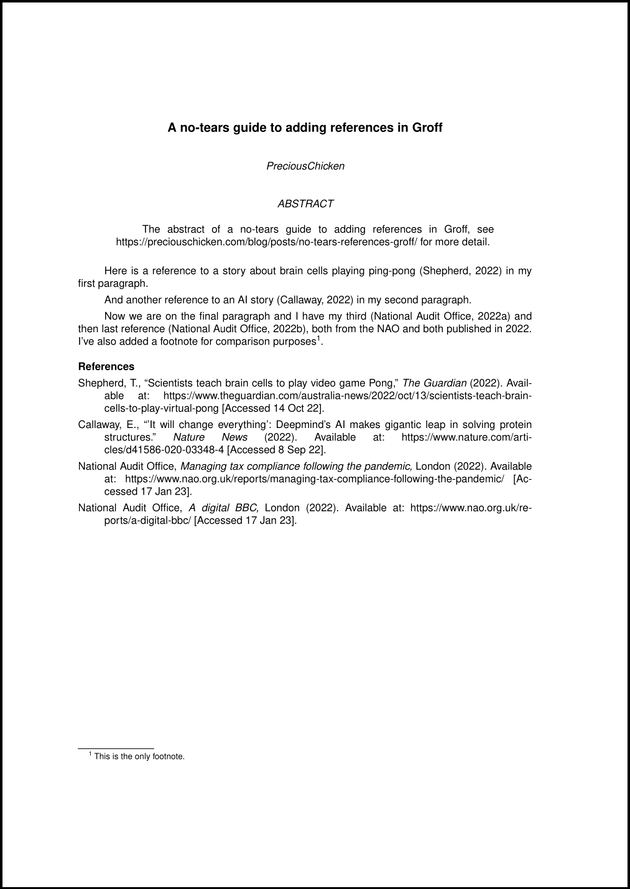A no-tears guide to adding references in Groff
Jan 17, 2023 13:10 · 938 words · 5 minute read
Introduction
Groff is a decades-old typesetting system present on most Linux distributions which uses an application called refer to add citations. I found adding citations using this mechanism a challenge, therefore as an aide-memoire this is a minimal worked example of adding references to a Groff document with the refer program. I’m using GNU Groff version 1.22.4, GNU refer (groff) version 1.22.4 on Manjaro Linux 22.0.0. I’m using the ms macro, but the basic principles should apply to most macros. All text examples can be found in the associated github repo.
Creating documents
First create the document we are placing the references into, so create a file named notears.ms and paste the following:
.R1 \" Citation commands start
database notears.bib # Path to bibliography file
accumulate # Collates References at end of documentation
move-punctuation # Ensures that citation appears before full-stop.
label "(A.n|Q) ', ' (D.+yD.y%a*D.-y)" # Actual format of citation (e.g. (Author, Date)
bracket-label " (" ) "; " # Bracket style
no-label-in-reference # Does not display full citation (e.g. Author, Date) within References
.R2 \" Citation commands end
.ds FAM H \" Sets font family
.TL
A no-tears guide to adding references in Groff
.AU
PreciousChicken
.AB
The abstract of a no-tears guide to adding references in Groff, see https://preciouschicken.com/blog/posts/no-tears-references-groff/ for more detail.
.AE
.PP
Here is a reference to a story about brain cells playing ping-pong
.[
shepherd22
.]
in my first paragraph.
.PP
And another reference to an AI story
.[
callaway20
.]
in my second paragraph.
.PP
Now we are on the final paragraph and I have my third
.[
nao22tax
.]
and then last reference,
.[
nao22bbc
.]
both from the NAO and both published in 2022. I've also added a footnote for comparison purposes\**.
.FS \" Footnote start
This is the only footnote.
.FE \" Footnote end.
The section starting .R1 and ending .R2 is where commands are added as to how the citations will displayed. These commands could also be entered on the command line rather than in the document text - but I prefer the latter as that keeps it all together if you are trying to recreate the document later. For a full list of the applicable commands see man(1) refer. The point where the citations are introduced into the text are marked by the opening .[ and closing .], with the keyword of the citation inbetween (e.g. callaway20).
Keen readers may note the comments format for the text between .R1 and .R2 follows a different format (comments begin with # not \") as this section is intended for the preprocessor refer and not groff itself.
Now we need to create the bibliography file that this document points to, so in the same folder1 create another file named notears.bib and paste:
%K shepherd22
%A Shepherd, T.
%B London
%D 2022
%T Scientists teach brain cells to play video game Pong
%J The Guardian
%O Available at: https://www.theguardian.com/australia-news/2022/oct/13/scientists-teach-brain-cells-to-play-virtual-pong [Accessed 14 Oct 22]
%K callaway20
%A Callaway, E.
%B London
%D 2022
%T 'It will change everything': Deepmind's AI makes gigantic leap in solving protein structures.
%J Nature News
%O Available at: https://www.nature.com/articles/d41586-020-03348-4 [Accessed 8 Sep 22]
%K nao22tax
%Q National Audit Office
%C London
%D 2022
%T Managing tax compliance following the pandemic
%O Available at: https://www.nao.org.uk/reports/managing-tax-compliance-following-the-pandemic/ [Accessed 17 Jan 23]
%K nao22bbc
%Q National Audit Office
%C London
%D 2022
%T A digital BBC
%O Available at: https://www.nao.org.uk/reports/a-digital-bbc/ [Accessed 17 Jan 23]
Each reference is separated by a blank line, with each field of the reference on a new line. Each reference line starts with the code for the field, so for instance %C is city of publication. The keyword we referred to in notears.ms is given on the %K line. Again for the guide see man(1) refer. The mom macro has also introduced some fields which were not in the original (for instance %l as translator).
Producing the PDF
We now have enough to produce a document with references. There are a number of commands2 you can use to produce the final file, but we’ll go for:
groff -R -m ms -T pdf notears.ms > notears.pdf
The -R option here being critical as it informs groff that there are references and to use the refer preprocesser before producing the final document.
If you now open the resulting notears.pdf with your pdf viewer of choice you should see:
Of note is that the National Audit Office citations are disambiguated - i.e. 2022a and 2022b. This is as a result of the rather cryptic D.+yD.y%a*D.-y code in the label field of the document - and is copied straight from man(1) refer.
Conclusion & further references
If you’ve found this useful please leave a comment below or star the github repo. You might also be interested in a previous post I wrote on producing correspondence letters in groff or if you are a vim user my vim plugin: vim-groff-viewer.
Apart from the man(1) refer page there is not a huge amount of concise online guidance on including references within groff, however a useful video is Luke Smith’s Your Brain Using REFER to do your bibliographies automatically in groff/troff.
-
The bibliography can be in another folder, in which case include the full path in the
databasecommand. ↩︎ -
You could also use
refer notears.ms | groff -m ms -T pdf > notears.pdforgrog -T pdf --run notears.ms > notears.pdforpdfroff -R -m ms notears.ms --pdf-output=notears.pdfall of which would produce the same result. Though interestingly in my testing I noticed that pdfroff used a more up to date version of the PDF format: v1.7 compared to the others using v1.4. ↩︎
